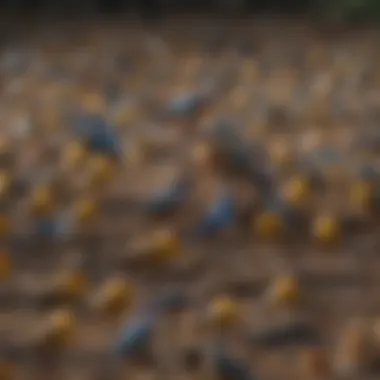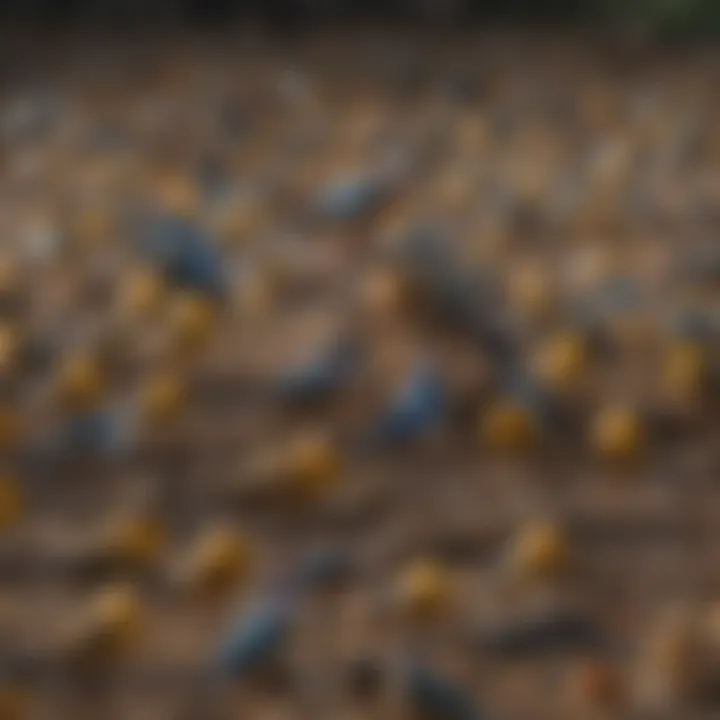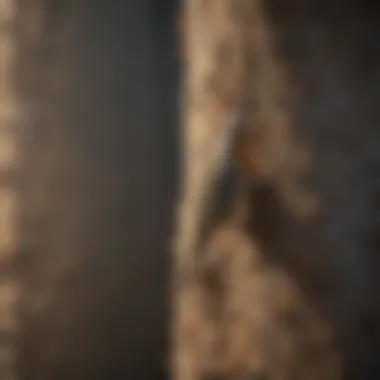Bird Exclusion Products: Comprehensive Overview


Intro
Birds, while often cherished for their beauty and song, can become significant nuisances in urban and residential settings. As they seek shelter, food, and nesting sites, they can cause extensive damage to buildings, roofs, and gardens. Understanding the types of birds that invade homes, their habits, and the corresponding exclusion products is critical for effective pest management.
This article will provide a detailed examination of the various bird exclusion products available, their applications, and how to implement them effectively. A systematic approach to preventing bird-related issues can help homeowners protect their properties while maintaining a balance with local wildlife.
Understanding the Pest
To effectively manage bird problems, one must first understand the pest.
Identification
Bird exclusion strategies typically begin with the identification of the specific birds causing issues. Common culprits include pigeons, sparrows, starlings, and swallows. Each species exhibits unique behaviors and preferences, which can influence the choice of exclusion methods. For instance, pigeons are often found roosting on ledges, while starlings tend to invade attics and eaves. Proper identification allows for a tailored approach.
Life Cycle
Understanding the life cycle of common pest birds enhances exclusion efforts. Most birds reproduce rapidly, with some species having multiple broods in a single year. For example, sparrows can produce up to five clutches annually. Knowing when these birds breed helps inform the timing of exclusion efforts, ensuring that any measures taken are most effective when populations are low.
Pest Prevention Strategies
Preventing bird infestations is often more effective than dealing with an established problem. Two major prevention strategies include environment modification and physical barriers.
Environment Modification
Creating an environment less conducive to nesting and feeding can deter pest birds. Some effective practices include:
- Removing food sources: Secure trash bins easily accessible to birds, and prevent birds from accessing seeds in gardens.
- Managing water sources: Eliminate standing water since birds are drawn to it for drinking and bathing.
- Landscaping adjustments: Trim tall trees or shrubs where birds might nest.
Physical Barriers
Physical barriers can prevent birds from accessing rooftops or other desired areas. Some common products include:
- Bird spikes: Installed on ledges and surfaces to make perching uncomfortable.
- Bird netting: Used to exclude birds from entering specific areas, such as gardens or rooftops.
- Visual deterrents: Items like reflective tape or fake predators can discourage birds from setting up residence.
Control Methods
When prevention fails, control methods may be necessary to manage avian populations effectively. Two prominent control approaches are chemical control and biological control.
Chemical Control
Chemical methods involve the use of specific products designed to repel birds. Some products are available in the form of sprays or granules that can discourage birds from nesting. Caution is necessary when employing these methods, as they can impact other wildlife and the surrounding environment.
Biological Control
Biological control focuses on utilizing natural methods to manage bird populations. This can include the introduction of bird species that naturally prey on common pest birds. While this method is less conventional and can take time to yield results, it promotes a balanced ecosystem.
"Understanding and addressing the ways birds interact with their environment is crucial for creating effective management strategies."
Prelims to Bird Exclusion
Bird exclusion is a vital topic that addresses the growing need to manage bird populations in urban and rural settings. Fostering a balance between human activities and wildlife is essential. As our environments continue to evolve, the integration of effective bird exclusion methods becomes critical. This section emphasizes the various facets of bird exclusion products and their role in promoting a harmonious coexistence.
Definition of Bird Exclusion
Bird exclusion refers to the strategic implementation of products and techniques designed to prevent birds from accessing specific areas. These areas may include buildings, agricultural lands, and commercial properties. The goal of bird exclusion is not to harm the birds but to deter them from nesting or congregating in spaces where they may cause damage or pose health risks. By utilizing various physical, visual, auditory, and chemical deterrents, property owners can create environments that discourage unwanted avian guests.
Importance of Bird Exclusion
The importance of bird exclusion cannot be overstated. Birds can cause significant problems when they enter human habitats. They often lead to property damage, particularly through nesting and droppings. Their droppings can carry diseases, contaminate food sources, and even lead to structural deterioration over time.
Moreover, the economic repercussions of bird infestations can be substantial, affecting businesses reliant on cleanliness and hygiene. For homeowners, the aesthetic and functional aspects of properties are at risk. Thus, effective bird exclusion strategies can not only protect physical spaces but also promote public health and safety.
Common Bird Species Targeted
Certain bird species are commonly targeted in exclusion efforts due to their tendencies to invade human spaces. Common examples include:
- Pigeons: Known for roosting on ledges and rooftops, they are often seen in urban environments.
- Sparrows: They can nest in small openings around buildings, causing mess and blockage.
- Starlings: These birds are notorious for large flocks and can cause noise and damage to crops.
- Seagulls: Particularly in coastal regions, they can create significant messes at businesses that cater to food.
By focusing on these species, property owners can establish targeted exclusion measures, leading to more effective outcomes.
Types of Bird Exclusion Products
Bird exclusion products serve a vital role in managing bird populations in urban and suburban settings. The diversity in bird exclusion techniques allows for tailored solutions depending on specific environments and targeted species. Understanding the landscape of bird exclusion products is important for determining which options yield the best results based on individual needs.
Physical Barriers
Netting Solutions
Netting Solutions function as physical barriers that prevent birds from accessing certain areas. This method is considered effective due to its ability to create a physical boundary without harming the birds. One significant characteristic of netting is its versatility; it can be applied in various settings, such as gardens, roofs, and warehouses. The key appeal of netting solutions lies in their unobtrusive nature, allowing for the maintenance of aesthetics while effectively deterring birds.


One unique feature of netting is its durability, often made from high-tensile materials that withstand harsh weather conditions. However, it may require proper installation and maintenance to ensure effectiveness over time.
Spike Systems
Spike Systems provide another method of creating a physical barrier. Comprising a series of spikes attached to surfaces, they deter birds from landing. This type of exclusion method has gained popularity because it is easy to install and maintain. The primary characteristic of spike systems is their effectiveness against larger birds, which often avoid landing on sharp objects.
Moreover, spike systems can be discreetly placed on ledges, roofs, and railings, minimizing visual disruption. The disadvantage lies in potential space limitations, as they can be less effective against agile or smaller birds that may navigate around them.
Visual Deterrents
Reflective Materials
Reflective Materials are designed to confuse and scare birds through flashes of light. These materials are an economical choice, as they can be made from simple items such as aluminum foil or reflective tape. The key characteristic is their ability to create unpredictable reflections, which can cause discomfort to birds. When considering visual deterrents, reflective materials often appeal to those seeking low-maintenance solutions.
A unique aspect of reflective materials is their adaptability; they can be installed in various locations like rooftops or gardens. However, their effectiveness may diminish over time as birds adapt to the visual cues.
Decoys
Decoys mimic natural predators, such as hawks or owls, to scare away unwanted birds. This method is highly popular for its simplicity and effectiveness in many gardens and commercial areas. The main characteristic of decoys is their visual resemblance to real predators, which can compel birds to avoid certain areas.
One unique feature is the ability to position decoys strategically for maximum impact. However, like reflective materials, decoys can lose effectiveness as birds become accustomed to their presence, necessitating occasional repositioning or replacement.
Auditory Deterrents
Noise Devices
Noise Devices create sounds that disturb birds, keeping them away from specific locations. These devices can be mechanical or electronic, designed to emit various noises ranging from alarms to distress signals. The most notable aspect of noise devices is their ability to deter birds across larger areas compared to some physical barriers.
Their appeal stems from the simplicity of positioning and often low ongoing costs. However, excessive noise may lead to disturbance for humans and other wildlife nearby, thus requiring mindful placement.
Predator Calls
Predator Calls utilize recorded sounds of birds' natural enemies. These calls serve to create an auditory illusion of danger, prompting birds to vacate an area. The defining characteristic of predator calls is their realism and effectiveness in simulating a threatening environment.
Furthermore, these calls can be automated, running at intervals to maintain effectiveness over time. Disadvantages include the potential for habituation if the calls are played too frequently without variation, diminishing their deterrent effect.
Chemical Repellents
Bird Repellent Gels
Bird Repellent Gels are formulated to discourage birds from landing on treated surfaces. These gels create a sticky surface that creates an uncomfortable sensation for birds but is non-toxic. One primary characteristic is their consistency, allowing easy application across various locations. Popular among homeowners, their health and environmental safety make them appealing options.
Unlike physical barriers, gels can be applied quickly and with minimal disruption. Allowing for flexibility in application presents a significant advantage. However, gels may need to be reapplied after heavy rain or over time due to degradation.
Nontoxic Sprays
Nontoxic Sprays serve as an alternative option to repellents. These sprays create unpalatable surfaces for birds, effectively discouraging them from perching. Their key appeal is their ease of application, allowing homeowners to quickly treat surfaces without extensive tools or skills.
The unique aspect of nontoxic sprays lies in their operational mechanism, as they do not harm birds but simply make areas distasteful. Some disadvantages include possible weather sensitivity, requiring repeated applications, particularly in storm-prone areas.
Overall, selecting the right type of bird exclusion product involves assessing the specific environment and targeted bird species while weighing advantages and disadvantages accurately.
Mechanisms of Action
Understanding the mechanisms of action for bird exclusion products is crucial for effective pest management. Each method operates differently, influencing bird behavior and making it essential to choose the right solution for your specific needs. By grasping how these products function, homeowners and pest control professionals can tailor their approaches to achieve optimal results.
Various factors come into play when considering these mechanisms, including the type of bird involved, the environmental context, and the installation methods.
Behavioral Analysis of Birds
Birds exhibit diverse behaviors shaped by their species, environment, and individual experiences. This behavioral analysis informs how exclusion methods should work. Many birds are creatures of habit, often returning to the same sites for nesting or feeding. Understanding this can help determine when and where to apply exclusion products effectively.
Factors that govern bird behavior include:
- Nesting habits: Some birds prefer particular materials or structures for nesting.
- Feeding patterns: Birds often return to sites with reliable food sources.
- Sensitivity to environmental changes: Birds can adapt quickly, necessitating flexible exclusion strategies.
By observing these behaviors, homeowners can more accurately predict bird activities and select exclusion products that disrupt those patterns without harming the birds.
Effectiveness of Physical Barriers
Physical barriers serve as a direct method to exclude birds from unwanted areas. Various forms, such as netting and spikes, effectively prevent access while offering minimal visual intrusion. Each physical barrier has its own strengths:
- Netting Solutions: They create a physical block and are particularly useful in larger areas.
- Spike Systems: These deter perching birds, ensuring they cannot comfortably settle on surfaces.
The effectiveness of these barriers largely depends on proper installation. Incorrect placement can result in birds finding ways around barriers, thus nullifying their purpose. Homeowners must evaluate the area thoroughly and choose durable materials that withstand environmental factors.
Impact of Visual and Auditory Deterrents
Visual and auditory deterrents can also play a significant role in bird exclusion. These strategies aim to disrupt bird behavior through non-physical means.
Visual deterrents, such as reflective materials and decoys, create an illusion of danger, discouraging birds from approaching. On the other hand, auditory devices use sounds, like predator calls, to alarm birds. The impact of these deterrents will vary by species and their learned behaviors.
- Reflective Materials: These can be hung or placed to catch light and create movement, causing discomfort for birds.
- Noise Devices: Installed strategically, they can create an environment that seems unsafe for birds.
It is crucial to remember that birds can become accustomed to these deterrents over time. Therefore, the implementation of a rotation strategy may enhance their long-term effectiveness.
Application of Bird Exclusion Products


The application of bird exclusion products is fundamental to effective and responsible pest management. Understanding how to properly implement these products can not only minimize bird-related issues but also protect the environment and enhance the living conditions of homeowners. Each step in the application process requires careful consideration and tailored approaches to meet the specific needs of the site and the species in question.
Site Assessment
A thorough site assessment is the foundation of any successful bird exclusion strategy. This involves evaluating the environment where the pests are present. Key elements to inspect during this assessment include:
- Roosting and nesting habits: Identifying where birds congregate informs the best methods to exclude them.
- Potential vulnerabilities: Look for openings and ledges that birds might utilize.
- Species identification: Different birds require varied exclusion methods, making this step crucial.
By conducting a site assessment, individuals can identify not just the problematic areas but also any unique circumstances that might influence the choice of exclusion products.
Product Selection
The type of bird exclusion product chosen can dramatically impact the effectiveness of the strategy.
Choosing the Right Type
Selecting the correct type of bird exclusion product involves understanding the specific circumstances of the area. Physical barriers like netting or spike systems may be suitable for larger spaces, while visual deterrents might be more effective for smaller, enclosed areas. A key characteristic of this selection process is assessing the levels of bird activity; more active areas may require stronger or more varied methods. Choosing the right type means utilizing the potential of each product to its fullest, ensuring that birds are effectively managed. However, it is important to recognize that each option has its benefits and limitations, which can influence overall effectiveness.
Consideration of Environmental Factors
Considering environmental factors when selecting bird exclusion products is equally vital. Weather conditions, surrounding vegetation, and the specific location can all affect how effective a product might be. A notable characteristic is how nearby flora can either repel or attract certain species. Unique features might include selecting materials that can withstand environmental stresses, such as high winds or heavy rainfall. Weighing these factors offers advantages like improved durability of the products used and tailored effectiveness for each scenario. This consideration not only contributes to the immediate goals of exclusion but also ensures long-term sustainability of the methods implemented.
Installation Techniques
Effective installation is a critical aspect of implementing bird exclusion products. Proper techniques vary by product type, but basic principles apply throughout. Ensure that the products are affixed securely to withstand any natural elements or bird interactions. Regular maintenance and checks should also be part of the installation strategy to ensure resilience over time.
In this way, application techniques do not just protect immediate interests but also promote a longer-term vision for managing bird populations in an ethical and sustainable manner.
"Careful planning and execution in the application of bird exclusion products can lead to sustainable living conditions for homeowners and a harmonious coexistence with nature."
Effectiveness and Limitations
Understanding the effectiveness and limitations of bird exclusion products is essential when considering their implementation. This section outlines how these products can both succeed and face challenges in real-world applications. It emphasizes the necessity of measuring success and recognizing potential obstacles to achieve optimal outcomes.
Measuring Success Rates
Measuring the success rates of bird exclusion products involves assessing how effectively they keep birds away from specific areas. Success can be defined in various ways: reduction in bird activity, decreased damage to property, or improved comfort in outdoor spaces. Homeowners can employ different methods to gauge this success. These include monitoring bird presence before and after product installation, conducting regular inspections, and utilizing feedback from users.
Some common metrics used may include:
- Bird Count: A simple tally of bird numbers in the area before and after applying exclusion products.
- Damage Assessment: Evaluating any physical harm to property or crops over time.
- User Satisfaction: Soliciting experiences from homeowners who have implemented these strategies.
Using these metrics, homeowners can determine the effectiveness of various exclusion strategies, thus enabling informed decisions about future efforts.
Potential Challenges
Bird exclusion methods are not without difficulties. Understanding these potential challenges is key for homeowners aiming for successful pest management.
Incorrect Installations
Incorrect installations of bird exclusion products often lead to ineffective results. A key aspect of this challenge is the technical nature of many products. For instance, netting or spikes must be deployed at precise angles and placements. A slight deviation could create gaps, through which birds may easily enter.
The primary characteristic of incorrect installations is their propensity to negate the intended benefits of chosen products. For homeowners, this can be frustrating and counterproductive. Additionally, inadequate installation poses long-term financial implications due to repeated purchases or remedial efforts.
The unique feature of this aspect is how critical attention to detail becomes when installing exclusion products. Homeowners often benefit from thorough guides, professional assistance, or training to ensure correct application. Not only does this reduce the incidence of ineffective efforts, but it may also improve overall satisfaction with the chosen solution.
Environmental Adaptations by Birds
Birds possess remarkable adaptability. This trait poses challenges for homeowners seeking exclusion solutions. Different bird species often develop strategies to navigate and overcome deterrents. For instance, they might learn to maneuver around spikes or netting, rendering them less effective over time.
This common characteristic illustrates how birds can adjust their behaviors based on environmental cues. Such adaptations are a significant concern when selecting exclusion products.
The unique feature of this aspect reveals the dynamic relationship between birds and exclusion products. Homeowners must recognize that while an exclusion product may be effective initially, ongoing monitoring and potential adjustments are essential for sustained success. Awareness and adaptability are crucial for homeowners as they work through these challenges.
Regulations and Ethical Considerations
When it comes to bird exclusion, understanding regulations and ethical considerations is essential. This topic shapes the framework within which exclusion products and methods must operate. As our societies evolve, a greater emphasis is placed on protecting wildlife while managing human-animal conflicts. A balance between effective pest control and ethical treatment becomes paramount. The following sections delve deeper into the legal aspects of bird exclusion and the demand for the humane treatment of these creatures.
Legal Framework for Bird Exclusion
The legal framework surrounding bird exclusion is shaped by various national and local laws. In many jurisdictions, certain bird species are protected under laws like the Migratory Bird Treaty Act in the United States. This act prohibits the killing, capturing, or possession of migratory birds without a permit. Thus, anyone considering bird exclusion must ensure compliance with these laws.
Failure to adhere may result in severe penalties, including fines or even criminal charges. For example, if a homeowner uses harmful chemicals without consulting relevant regulations, they could unintentionally violate guidelines.
In addition, local ordinances can dictate how exclusion methods should be performed, specifying what materials are acceptable and the kinds of technologies that can be used. Understanding these rules assists homeowners and pest control professionals alike in making informed decisions.
Ethical Treatment of Birds
Ethical considerations play a crucial role in bird exclusion practices. It is important to prioritize humane methods. Using physical barriers or non-lethal repellents can effectively deter birds without causing them harm. Employing humane techniques aligns with broader societal values that stress the importance of protecting wildlife and the environment.


In addition, the ethical treatment of birds also involves considering their habitat and nesting season. For instance, during nesting periods, certain actions may disturb bird populations. Consequently, it is advisable to conduct a site assessment before any exclusion activities, ensuring that the timing is appropriate.
Furthermore, educating oneself about the bird species in the area can foster a greater respect for wildlife. Knowing the behaviors and needs of these birds can lead to more effective and ethical exclusion methods.
It is essential to strike a balance between human needs and the protection of wildlife. The choices made today affect bird populations for the future.
Sustainable Practices in Bird Exclusion
Sustainable practices in bird exclusion are increasingly vital in the context of environmental conservation and responsible pest management. Implementing strategies that not only deter birds but do so in an eco-friendly manner can lead to lasting benefits for both homeowners and the ecosystem. By focusing on sustainability, we can minimize harm to non-target wildlife, reduce chemical usage, and promote methods that support biodiversity.
Adopting sustainable practices helps create a balance between human needs and the natural world. Educating homeowners about humane and effective methods for bird exclusion plays a crucial role in fostering an environment that respects wildlife. As such, sustainable practices in bird exclusion can include a variety of tactics that are designed not just for effectiveness, but for minimal environmental impact.
Eco-friendly Product Options
Eco-friendly product options are critical for those looking to manage bird populations without compromising ecological integrity. These products often rely on materials and methods that are benign to the environment.
- Bird Spikes: Made from stainless steel or durable plastic, bird spikes physically prevent birds from landing on surfaces without causing them harm.
- Bird Netting: Non-toxic and highly effective, netting can protect fruit trees and gardens without impacting the birds' local populations.
- Plant-Based Repellents: Certain sprays formulated from natural ingredients can deter birds without introducing harmful chemicals into the environment.
- Sound Devices: Environmental sounds crafted to mimic natural predator calls can help to keep unwanted birds at bay without causing harm.
Choosing these eco-friendly options reduces the likelihood of negative impacts on non-target species, making bird exclusion a more responsible endeavor.
Long-term Management Strategies
Long-term management strategies in bird exclusion focus on creating and maintaining habitats that discourage birds from becoming pests. Such strategies can lead to substantive change, rather than temporary solutions.
- Landscaping Techniques: Designing gardens with less attractive plants for certain bird species can help minimize the attraction of unwanted birds to areas around homes.
- Habitat Modification: Changing physical features of properties, such as removing nesting sites, can deter birds from establishing themselves nearby.
- Community Involvement: Educating neighborhoods about bird behaviors and effective exclusion methods can lead to a collective effort, amplifying the impact of individual actions.
- Seasonal Monitoring: Keeping track of bird populations and behaviors can help in adapting exclusion methods as needed, ensuring that strategies stay relevant and effective over time.
By integrating these long-term strategies, homeowners can significantly reduce bird-related issues while nurturing the environment, ultimately ensuring the balance between residential needs and wildlife conservation.
Case Studies
Examining case studies is essential in the discussion of bird exclusion products. These real-world examples provide insights into the practical application of different methods and products. They highlight what works well in certain circumstances and where challenges may arise. Beyond theoretical assessments, case studies ground the information in practical reality, offering valuable lessons that can guide future applications.
Successful Implementations
Successful implementations of bird exclusion products illustrate effective strategies and outcomes. For instance, a well-documented case involves the use of netting solutions on a commercial building in a densely populated urban area. After assessing the challenge posed by nesting pigeons, the property management team decided on heavy-duty bird netting.
Following installation, the property saw a significant decrease in pigeon activity. Not only did this prevent further nesting, but it also improved the overall cleanliness of the area, as droppings often lead to health hazards. The management team noted that the investment paid off swiftly, with lower maintenance costs and improved aesthetics.
Lessons Learned
Lessons from implemented case studies provide critical takeaways. One case study from a residential neighborhood showed the importance of site assessment prior to installation. Residents initially chose reflective materials as deterrents for sparrows and starlings. However, feedback revealed that some birds adapted quickly to these visual methods.
This highlighted a crucial lesson: thick evaluations of local bird behavior and environmental conditions are vital. The residents later switched to noise devices which proved more effective. Such experiences emphasize that no single method guarantees success; a combination tailored to specific situations often yields the best results.
This reinforces the idea that ongoing evaluation is key in bird management. Understanding local bird behavior and the surrounding environment translates into better choices in exclusion methods.
Future Trends in Bird Exclusion
Understanding the future trends in bird exclusion is critical for homeowners and pest control professionals. This section highlights potential advancements and shifts in practices that can enhance bird management effectiveness. As pest control continues to evolve, the implementation of innovative products and methods ensures better outcomes for residents as well as the environment. Awareness of these trends not only helps in selecting suitable strategies but also promotes sustainable practices in managing avian populations.
Innovations in Technology
Emerging technology is influencing the development of bird exclusion products. New materials and design methodologies are becoming common. For instance, smart netting systems have been implemented that can adjust based on environmental conditions. These nets use sensors to detect when birds are approaching and can change shape or positioning, making it more difficult for birds to access certain areas.
Furthermore, there is a rise in the use of unmanned aerial vehicles (UAVs) equipped with cameras. These drones can monitor large areas for bird activity, allowing for real-time adjustments to exclusion strategies. This proactive approach can prevent problem situations before they escalate.
Additionally, many organizations are investing in research for biodegradable exclusion devices. Such products reduce environmental impact, aligning with the growing demand for eco-friendly pest management solutions.
"Innovations in bird exclusion technology drastically improve both efficiency and environmental sustainability."
Potential New Methods
Exploration into novel methods of bird exclusion is currently taking place. One interesting concept being explored involves the use of natural predators or robotic decoys to deter birds. By simulating the presence of natural threats, these methods can provide an effective means of discouraging birds from nesting or frequenting specific areas.
Moreover, researchers are investigating biological repellents derived from natural sources. These products, in contrast with traditional chemical repellents, aim to minimize harm to the surrounding ecosystem while still effectively deterring birds.
Lastly, ongoing studies into bird behavior and migration patterns continue to provide insights. This data can inform developments in tailored exclusion strategies. By understanding the specific behaviors of local bird species, it is possible to craft customized approaches that are more successful than generic solutions.
Ending
The importance of an informed approach cannot be overstated. As we've discussed, understanding the specific types of bird exclusion products available is fundamental. Each option, from physical barriers to chemical repellents, offers distinct benefits. The choice between these methods depends largely on the specific needs of a situation. Thus, careful assessment and research are paramount in selecting the right tools and techniques.
Moreover, sustainability emerges as a pivotal theme in modern pest management. Opting for eco-friendly bird exclusion products not only addresses immediate concerns but also considers the long-term effects on the environment. This perspective aligns with a growing interest in responsible stewardship of natural resources.
Finally, the integration of technological advancements into bird exclusion strategies promises improved effectiveness. The innovations available can lead to more humane and efficient solutions. Being proactive in adopting these methods can save time, resources, and uphold ethical standards.
"A comprehensive understanding of the mechanisms of action involved in bird exclusion can streamline efforts and ensure successful outcomes."
Equipped with knowledge about the various bird exclusion products, their applications, and associated best practices, individuals can feel empowered to make informed decisions that suit their unique situations.
Summary of Key Points
- Bird exclusion is necessary to prevent property damage and ensure safety.
- Different types of products serve different purposes, including physical, visual, auditory, and chemical methods.
- Sustainable practices are increasingly important in pest management.
- Making informed choices can lead to better long-term results and ethical outcomes.
Recommendations for Best Practices
- Conduct Site Assessments: Always begin by evaluating the problem area. Understanding the local bird populations and their behaviors will inform the selection of exclusion products.
- Choose the Right Product: Different circumstances call for different solutions. For instance, netting can be effective for large areas, while spikes might serve well on ledges.
- Follow Installation Guidelines: Correct installation is essential for ensuring product effectiveness. Follow manufacturer guidelines meticulously.
- Consider Environmental Impact: Whenever possible, select eco-friendly products that minimize harm to non-target species.
- Monitor Results: After installation, regularly check the effectiveness of the exclusion measures and make adjustments as needed.







